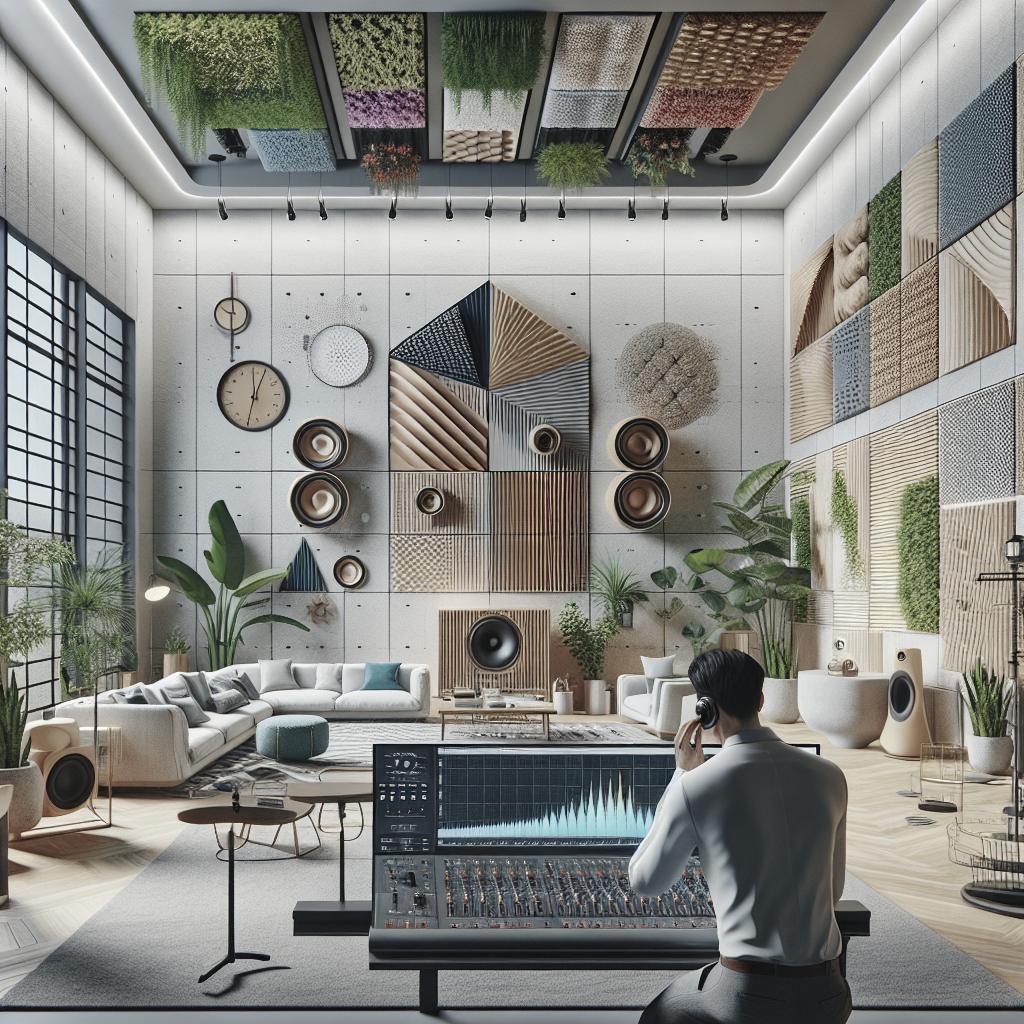When it comes to interior spaces, acoustics play a vital role in shaping the overall experience of an environment. Whether you’re designing a hospital, a recording studio, a school, or a government room, understanding room acoustics and implementing the right solutions can dramatically impact sound quality. This comprehensive guide will walk you through the nuances of optimizing acoustics in various settings, exploring factors that influence sound performance and why thoughtful acoustic design matters. From product type considerations to industry-specific tips, we’ll delve into practical strategies that suit your specific needs. We’ll also introduce you to Acoustical Surfaces, Inc. and additional resources to equip you with essential tools and insights. Whether you’re tackling an echo-filled room or creating spaces for enhanced audio experiences, this article is your roadmap to a more acoustically-friendly environment. ### What Are Room Acoustics? Room acoustics refer to how sound behaves within an enclosed space. It’s the art and science of managing sound waves as they interact with walls, ceilings, floors, and other objects within a room. Understanding room acoustics involves analyzing how sound is reflected, absorbed, or diffused within a given area and how these phenomena influence the quality and clarity of sound. To improve room acoustics effectively, one must consider the room’s size, shape, and the materials present. Each element influences sound in unique ways. For example, harder surfaces tend to reflect sound, leading to echoes and reverberation, while softer surfaces absorb sound, reducing noise levels and improving clarity. A well-designed acoustic environment can create a balanced and pleasant auditory experience. ### What Impacts Room Acoustics? Several factors impact room acoustics, including the dimensions of a space, construction materials, and the interior design elements. Rooms with high ceilings, irregular shapes, or large glass surfaces can often experience poor acoustics, leading to sound distortion or echoing. Additionally, the presence of furniture and décor can either absorb or reflect sound, influencing the overall acoustic quality. The choice of materials is a significant determinant in room acoustics. Materials like concrete, glass, and tiles are reflective and can cause reverberation, whereas carpets, curtains, and acoustic panels are absorptive and help in reducing sound echo and enhancing clarity. Moreover, proper placement of these materials and understanding their absorption coefficients is crucial in achieving optimal acoustics. ### Why is Acoustic Design Important? Acoustic design holds immense importance in creating environments conducive to clear communication and a comfortable listening experience. Poor acoustics can lead to difficulties in understanding speech, distorted sounds, and an overstimulating noise environment, which can be detrimental in settings like schools or hospitals. Thoughtful acoustic design can enhance productivity, improve communication, and create a sense of well-being. In professional environments, such as recording studios, precise acoustic control ensures sound quality is maintained, while in educational settings, improved acoustics can enhance learning experiences, understanding, and concentration among students. ### How to Improve Room Acoustics for Your Industry The process of enhancing room acoustics varies significantly based on the specific requirements and functions of different industry settings. By understanding the unique demands of each setting, you can tailor your approach to achieve desirable acoustic outcomes. #### Browse by Application Adapting acoustic solutions to fit specific applications ensures optimal sound quality for the intended use of an interior space. Each application has distinctive needs and addressing these through targeted solutions is crucial for effective acoustic management. #### Browse by Product Type Different acoustic products serve varied purposes, whether it’s soundproofing, enhancing sound quality, or controlling noise levels. Familiarizing yourself with the available product types, such as acoustic panels, ceiling tiles, or soundproofing materials, will enable better choices based on your specific requirements. #### Hospitals In hospitals, acoustics play a critical role in staff efficiency, patient recovery, and overall well-being. Excessive noise can disrupt sleep, increase stress, and interfere with communication among healthcare providers. To improve hospital acoustics, consider installing sound-absorbing panels in corridors, patient rooms, and waiting areas to reduce echo and enhance speech intelligibility. #### Recording Studios For recording studios, achieving top-notch acoustics is essential for high-quality audio production. The focus is on minimizing external noise interference and optimizing sound clarity within the recording space. This can be accomplished through the use of diffusers, bass traps, and strategically placed absorptive materials to create a balanced acoustic environment that captures sound accurately. #### Schools Effective acoustics in schools are vital for promoting learning and communication. Poor acoustics can hinder speech intelligibility, making it challenging for students to engage in classroom discussions or understand lectures. Incorporating acoustic tiles on ceilings, and panels on walls, and managing noise through soft furnishings can enhance the learning environment significantly. #### Government Rooms Government rooms often serve as venues for important discussions, meetings, and decision-making. Consequently, clear acoustics are imperative for effective communication and confidentiality. Ensuring appropriate reverberation times and installing sound masking systems can help maintain a clear and secure auditory space. ### Enhance Your Room Acoustics with Acoustical Surfaces, Inc. Acoustical Surfaces, Inc. offers a comprehensive selection of acoustic products tailored to meet the needs of different settings. By understanding your goals and the specific challenges you face, Acoustical Surfaces, Inc. can provide customized solutions that enhance sound quality and address sound control challenges effectively. From soundproofing materials to acoustic panels and ceiling tiles, their products are designed to optimize the acoustic performance of any space. With expert guidance, you can achieve the perfect balance of sound absorption and diffusion, ensuring a high-quality acoustic environment. ### Additional Resources #### Creating Better-Sounding Rooms To further your understanding, explore additional reading materials and guides on creating better-sounding rooms. These resources can expand your knowledge on advanced acoustic strategies and innovative approaches to sound management. #### Solutions to Common Noise Problems Familiarize yourself with solutions to common noise problems, such as reverberation, sound leakage, or echo, by accessing expert tips and troubleshooting techniques. These resources can assist in identifying practical methods to address noise issues effectively. #### CAD, CSI, & Revit Library Access the CAD, CSI, and Revit library for detailed product specifications and design assistance. This library is a valuable resource for architects, designers, and builders looking to integrate high-quality acoustical solutions into their projects seamlessly. #### Leave a Reply Cancel reply. Engage with experts and peers by participating in discussions or leaving comments or feedback. This collaborative approach can lead to shared insights and innovative solutions to achieve optimal acoustics in diversified environments. ### Final Thoughts The table below summarizes the key components discussed in this blog post for quick reference: “`html
| Section | Highlights |
|---|---|
| What Are Room Acoustics? | Understanding how sound behaves within a space and managing sound waves effectively. |
| What Impacts Room Acoustics? | The influence of room dimensions, construction materials, and interior design on room acoustics. |
| Why is Acoustic Design Important? | The significance of acoustic design in enhancing communication and creating conducive environments. |
| How to Improve Room Acoustics for Your Industry | Customizing acoustic solutions based on industry-specific requirements, covering hospitals, recording studios, schools, and government rooms. |
| Enhance Your Room Acoustics with Acoustical Surfaces, Inc. | Utilizing Acoustical Surfaces, Inc.’s expertise and product range to improve room acoustics. |
| Additional Resources | Exploring further reading, solutions, and resources like the CAD, CSI, & Revit Library to assist in acoustic optimization. |
“` In this guide, the emphasis on tailored solutions highlights how diverse settings can benefit from enhanced acoustics, encouraging thoughtful design and product choices that support better sound environments in both professional and everyday spaces.


